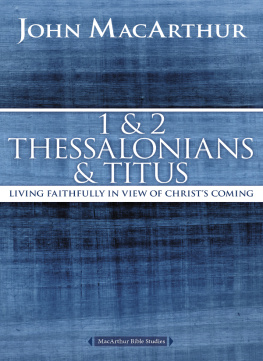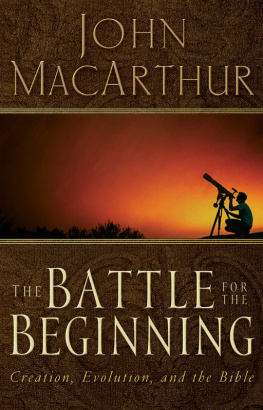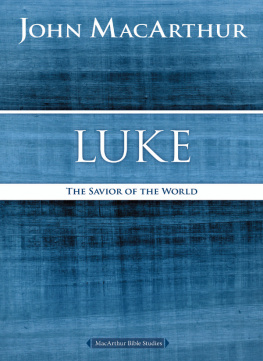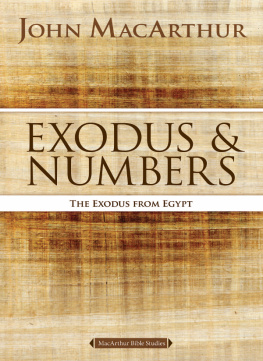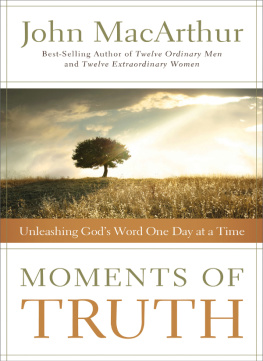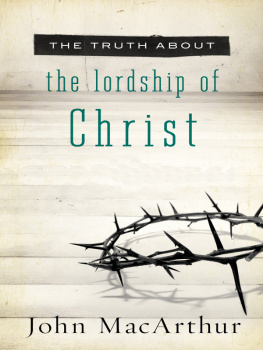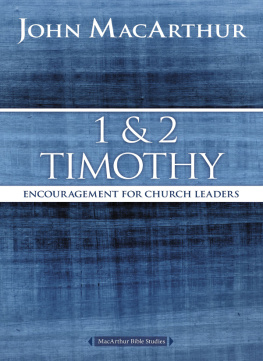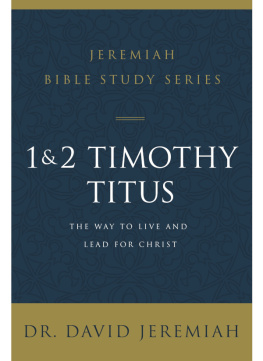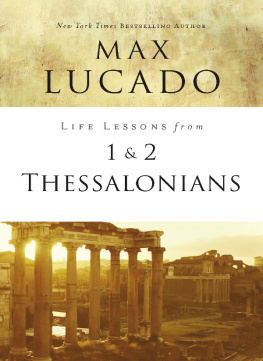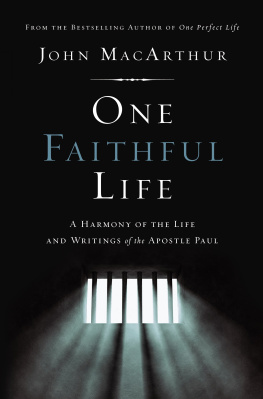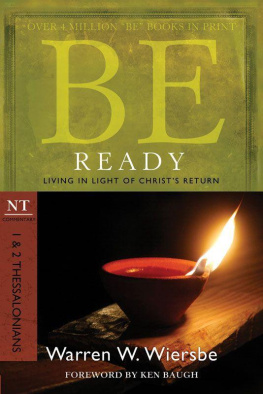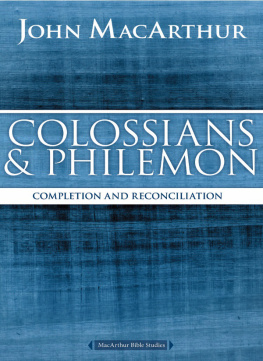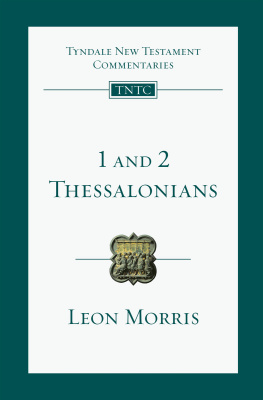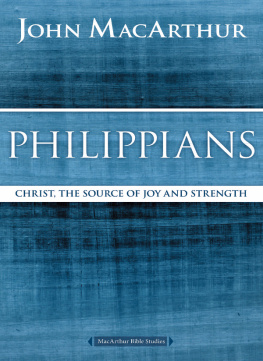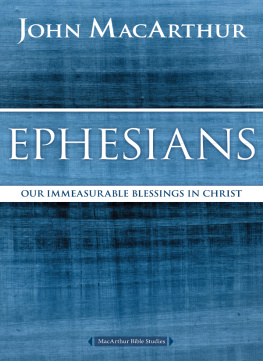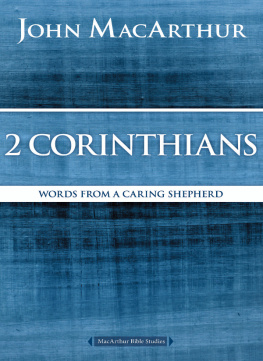
1 & 2 THESSALONIANS & TITUS
MACARTHUR BIBLE STUDIES
2007, by John MacArthur.
All rights reserved. No portion of this book may be reproduced, stored in a retrieval system, or transmitted in any form or by any meanselectronic, mechanical, photocopy, recording, or any otherexcept for brief quotations in printed reviews, without the prior permission of the publisher.
Published in Nashville, Tennessee, by Nelson Books, an imprint of Thomas Nelson. Nelson Books and Thomas Nelson are registered trademarks of HarperCollins Christian Publishing, Inc.
Nelson Books titles may be purchased in bulk for education, business, fundraising, or sales promotional use. For information, please email SpecialMarkets@ThomasNelson.com
Produced with the assistance of the Livingstone Corporation. Project staff include Jake Barton, Mary Horner Collins, and Andy Culbertson. Project editor: Len Woods
Scripture quotations marked NKJV are taken from The Holy Bible, New King James Version. 1979, 1980, 1982, 1992 Thomas Nelson, Inc. Publishers.
Unleashing Gods Truth, One Verse at a Time is a trademark of Grace to You. All rights reserved.
Keys to the Text and Truth for Today material is taken from the following sources:
Ashamed of the Gospel. 1993 by John MacArthur. Published by Crossway Books, Wheaton, Illinois. Used by permission.
How to Meet the Enemy (electronic ed.). 1992, 1996 by John MacArthur. Published by Victor Books: Wheaton, Illinois. Used by permission.
The MacArthur Study Bible (electronic ed.), John MacArthur, General Editor. 1997 by Word Publishing. All rights reserved. Used by permission.
Matthew (electronic ed.). MacArthur New Testament Commentary Series. 1989 by John MacArthur. Published by Moody Press, Chicago, Illinois. Used by permission.
1 & 2 Thessalonians. MacArthur New Testament Commentary Series. 2002 by John MacArthur. Published by Moody Press, Chicago, Illinois. Used by permission.
Titus (electronic ed.). MacArthur New Testament Commentary Series. 1996 by John MacArthur. Published by Moody Press, Chicago, Illinois. Used by permission.
Cover Art by Holly Sharp Design
Interior Design and Composition by Joel Bartlett, Livingstone Corporation
ISBN: 978-0-7180-3513-6
ISBN 978-0-7180-3532-7 (eBook)
In this ebook edition, please use your devices note-taking function to record your thoughts wherever you see the bracketed instructions [Your Notes] or [Your Response Here]. Use your devices highlighting function to record your response whenever you are asked to checkmark, circle, underline, or otherwise indicate your answer(s).
CONTENTS
In the Greek New Testament, 1 Thessalonians is listed literally as To the Thessalonians. This represents the apostle Pauls first canonical correspondence to the church in the city of Thessalonica.
AUTHOR AND DATE
The apostle Paul identified himself twice as the author of this letter (1:1; 2:18). Silvanus (Silas) and Timothy (3:2, 6), Pauls traveling companions on the second missionary journey, when the church was founded (Acts 17:19), were also mentioned in Pauls greeting (1:1). Though Paul was the single inspired author, most of the first-person plural pronouns (we, us, our) refer to all three men. However, during Timothys visit back to Thessalonica, they refer only to Paul and Silvanus (3:1, 2, 6). Paul commonly used such editorial plurals because the letters came with the full support of his companions.
Pauls authorship has not been questioned until recently by radical critics. Their attempts to undermine Pauline authorship has failed in light of the combined weight of evidence favoring Paul, such as: (1) the direct assertions of Pauls authorship (1:1; 2:18); (2) the letters perfect correlation with Pauls travels in Acts 1618; (3) the multitude of intimate details regarding Paul; and (4) the confirmation by multiple, early historical verifications, starting with Marcions canon in AD 140.
The first of Pauls two letters written from Corinth to the church at Thessalonica is dated ca. AD 51. This date has been archeologically verified by an inscription in the temple of Apollos at Delphi (near Corinth) which dates Gallios service as proconsul in Achaia to AD 5152 (Acts 18:1217). Since Pauls letter to the churches of Galatia was probably written ca. AD 4950, this was his second piece of canonical correspondence.
BACKGROUND AND SETTING
Thessalonica (modern Salonica) lies near the ancient site of Therma on the Thermaic Gulf at the northern reaches of the Aegean Sea. This city became the capital of Macedonia (ca. 168 BC) and enjoyed the status of a free city, which was ruled by its own citizenry (Acts 17:6) under the Roman Empire. Because it was located on the main east-west highway, Via Egnatia, Thessalonica served as the hub of political and commercial activity in Macedonia and became known as the mother of all Macedonia. The population in Pauls day reached 200,000 people.
Paul had originally traveled 100 miles from Philippi via Amphipolis and Apollonia to Thessalonica on his second missionary journey (AD 50; Acts 16:118:22). As was his custom upon arrival, he sought out the synagogue in which to teach the local Jews the gospel (Acts 17:12). On that occasion, he dialogued with them from the Old Testament concerning Christs death and resurrection in order to prove that Jesus of Nazareth was truly the promised Messiah (Acts 17:2, 3). Some Jews believed, and soon after Hellenistic proselytes and some wealthy women of the community also were converted (Acts 17:4). Mentioned among these new believers were Jason (Acts 17:5), Gaius (Acts 19:29), Aristarchus (Acts 20:4), and Segundus (Acts 20:4).
Because of their effective ministry, the Jews had Pauls team evicted from the city (Acts 17:59), so they went south to evangelize Berea (Acts 17:10). There Paul had a similar experience to Thessalonica, with conversions followed by hostility; so the believers sent Paul away. He headed for Athens, while Silvanus and Timothy remained in Berea (Acts 17:1114). They rejoined Paul in Athens (see Acts 17:15, 16 with 3:1), from which Timothy was later dispatched back to Thessalonica (3:2). Apparently, Silas traveled afterwards from Athens to Philippi while Paul journeyed alone to Corinth (Acts 18:1). It was after Timothy and Silvanus rejoined Paul in Corinth (Acts 18:5), that he wrote 1 Thessalonians in response to Timothys good report of the church.
Paul undoubtedly had multiple reasons for writing, all coming out of his supreme concern for the flock from which he had been separated. Some of Pauls purposes clearly included: (1) encouraging the church (1:210); (2) answering false allegations (2:112); (3) comforting the persecuted flock (2:1316); (4) expressing his joy in their faith (2:173:13); (5) reminding them of the importance of moral purity (4:18); (6) condemning the sluggard lifestyle (4:912); (7) correcting a wrong understanding of prophetic events (4:135:11); (8) defusing tensions within the flock (5:1215); and (9) exhorting the flock in the basics of Christian living (5:1622).
HISTORICAL AND THEOLOGICAL THEMES
Both letters to Thessalonica have been referred to as the eschatological epistles. However, in light of their more extensive focus upon the church, they would better be categorized as the church epistles. Five major themes are woven together in 1 Thessalonians: (1) an apologetic theme with the historical correlation between Acts and 1 Thessalonians; (2) an ecclesiastical theme with the portrayal of a healthy, growing church; (3) a pastoral theme with the example of shepherding activities and attitudes; (4) an eschatological theme with the focus on future events as the churchs hope; and (5) a missionary theme with the emphasis on gospel proclamation and church planting.
Next page
